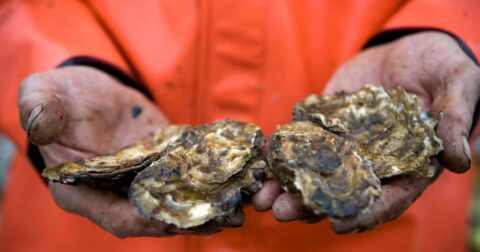Explainer
How Overconsumption Affects the Environment and Health, Explained
Climate•12 min read
Reported
Over 90 percent of food harvested from marine and freshwater environments is at risk, challenging the idea that “blue food” is more sustainable.


Words by Jennifer Mishler
Seafood has been sold to consumers as the sustainable “meat” of the future — an alternative to methane-spewing beef and all of its environmental damage. The message has caught on: the world’s demand for seafood is projected to double by 2050, with fish farming making up around half of the world’s fish supply. But while some attention has been paid to the environmental harms of fish farming and wild-capture fisheries, the potential damage that climate change might cause the seafood industry has largely been able to fly under the radar. Now, a new study concludes that over 90 percent of seafood production is vulnerable to climate change. It raises doubts as to whether so-called “blue food” — food harvested from freshwater and marine environments — can truly stand the test of time.
Producers in the U.S. and Asia face the most significant climate threats, according to the study. Asian nations including China, India, Japan and Vietnam contribute 85 percent of the world’s aquaculture and 45 percent of its wild marine catch. The U.S. was among the nations most commonly impacted by “high exposure to inland eutrophication” — or water pollution from nutrients like manure and fertilizer, as well as “inland warming, altered precipitation and sea level rise.” Other regions, such as nations in Latin America, are also highly affected by climate change but may have less economic capacity to be able to adapt, the researchers conclude.
The new study reveals the staggering vulnerability of aquaculture to climate change, even as the booming industry tries to position itself as a more sustainable alternative for so-called climavores. Yet some past research did signal a future threat. In 2021, UK researchers warned that “the aquaculture sector is increasingly being threatened by human-driven climate change effects that are both a present and future reality,” despite the widely held belief that fish farming is a critical climate solution.
Warming waters could facilitate more disease outbreaks, the scientists found, and the projected rise in CO2 in our oceans could also decimate sea life. The study points out that there has been little study of climate impacts on seaweed production — which could evade some of the risks of fish farming and serve as an alternative. (Seaweed is considered by many to be important for not just its nutritional value, but also as a potential carbon sink.)
Though the research into climate impacts on the seafood industry has been scant, analysis conducted by the FAO back in 2015 did reveal some concerns about sustainability — even as researchers placed most of the blame on overfishing.
Even then, the FAO noted that aquaculture might not be any better adapted to climate change than the fishing industry. “[W]hile aquaculture systems…appear less vulnerable in some cases than capture fisheries systems… the opposite is true in other cases,” the FAO concluded. “This suggests that the oft heard statement that ‘aquaculture will fill the gap for declining capture fisheries’ may not hold true in all instances.”
Still, the aquaculture industry skyrocketed in the years that followed the FAO forecast. Over 116 million tons of seafood was produced by global aquaculture in 2015. In 2020, the sector’s output reached a record-high volume of nearly 236 million tons — over 60 percent higher than the average production of the 1990s, according to FAO, which argued in 2022 that a “blue transformation” is needed if the industry is to become sustainable and withstand climate impacts.
Globally, the most commonly farmed aquatic species are salmon and shrimp. In fact, nearly all Atlantic salmon is produced on farms, and over half of the world’s shrimp comes from aquaculture.
In 2015, research revealed that shrimp farmers in Bangladesh were already struggling against the effects of a changing climate such as coastal flooding, rising surface temperatures, sea level rise and more. The study concluded that the industry is facing “extreme vulnerability” to climate change.
Researchers have suggested that the aquaculture sector’s lack of diversity — and particularly aquaculture’s dependence on Atlantic salmon — is one reason why it is threatened by environmental impacts.
Raised in crowded conditions, much like factory-farmed animals on land, farmed shrimp and salmon alike become even more vulnerable to disease as water temperatures rise. Shrimp are especially sensitive to changes in temperature, water quality and stress.
Researchers have also found that rising water temperatures can cause mass salmon die-offs on fish farms, where salmon are unable to escape the conditions. “[U]like their wild relatives, they have no hope of migrating to cooler water,” reports YaleEnvironment 360. “Since farmed salmon cannot adapt, the aquaculture industry itself must change — or face its own decline.”
To many who study or work to address the inefficiencies of our food system, plant-based and cultivated seafood offer a more sustainable alternative to fish, and a lasting way to meet the world’s ever-growing demand for so-called blue food.
“Alternative seafood doesn’t rely on wild population productivity or geographical considerations,” according to a report by the Good Food Institute, an organization that advocates for alternative proteins. “Supply chains and raw materials for alternative proteins are significantly less constrained than conventional seafood supply chains, so plant-based and cultivated seafood can be produced consistently.”
Alternative seafood products can be made more sustainably with ingredients like mushrooms or soy, and require “fewer natural resources and far less harm to our environment,” the Good Food Institute concludes.
In other words, the plant-based and cultivated seafood industries may be less vulnerable to the impacts of climate change, while also contributing less to it.